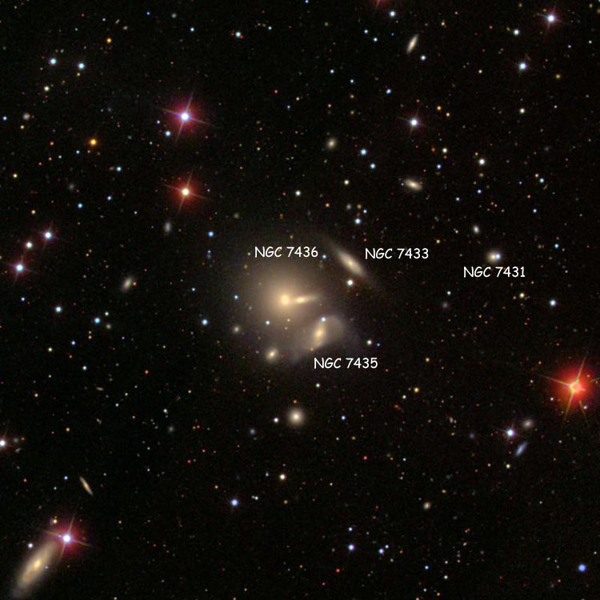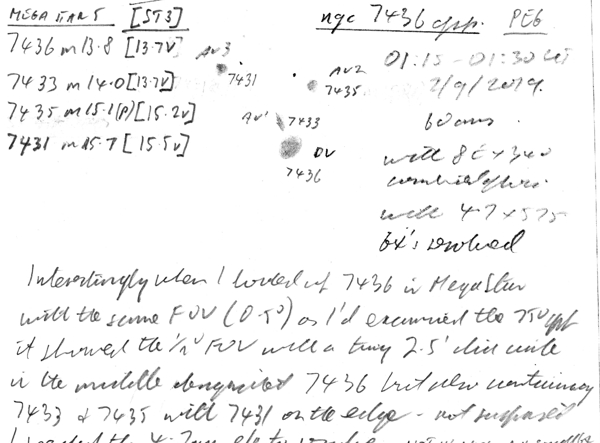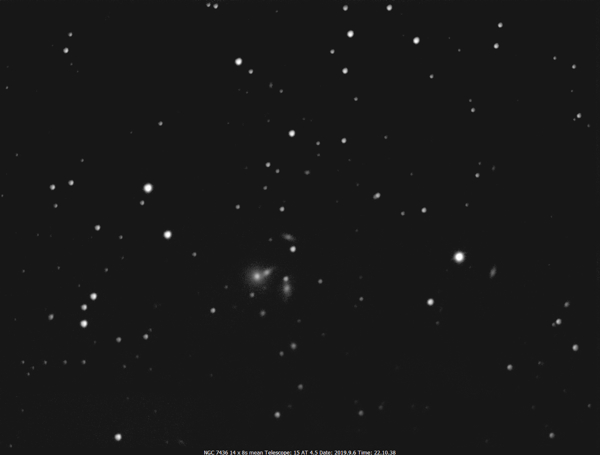NGC 7436 in Pegasus
November 2019 - Galaxy of the Month
This small tight group of galaxies in Pegasus has an interesting discovery history. The brightest galaxy NGC 7436 was discovered by William Herschel in December 1784. However he was not able to resolve the other members of the group and it took Mitchell using the 72” at Birr to find NGC 7433 and NGC 7435 in 1855 and then Bigourdan added the last NGC member of the group (NGC 7431) in 1886.
The group are also listed as VV 84 in the Voronstov-Velyaminov catalogue of interacting galaxies where he included it in his group of triples with a tight pair, although the group did not get the attention of Arp.
Dreyer did note another galaxy in the group in 1875 but was not confident enough in his sighting as it was a bad night to list it. This may be the faint galaxy MCG +4-54-7.
Unfortunately there is some confusion about the NGC designations in this group with the nomenclatures NGC 7436A and B being used for the central galaxy and not necessarily for the same objects.
Mitchell and Dreyer did provide drawings of the field however which helps in trying to establish what galaxies they saw. The associated chart and image below will show how different galaxies are assigned different numbers.

The group also exists as part of WBL 692, which appears to consist of just the galaxies catalogued in the NGC. The group, also known as Holmberg 800, lies on the outskirts of the galaxy cluster Abell 2153 and is at about 340 million light-years distant from us.
NGC 7436 itself appears to be an elliptical galaxy with a large outer halo, suggestive of it snacking on other galaxies in the past. That fuzziness makes it difficult to decide if the little galaxy next to it lies in front or behind NGC 7436. NGC 7435 shows signs of an interaction with its distorted spiral arms although it is probably not with NGC 7436 as its recession velocity suggests that it lies behind it. It may be that NGC 7436 is only marginally part of the group of galaxies that we see. There are a number of other faint galaxies in the field including UGC 12274.
The compactness of the group suggests that to get much out of this will require a night of steady seeing and high power. Observations from Andrew Robertson using a 24” and Mike Wood using a 15” Obsession with an EAA system are included below. Also see Steve Gottlieb’s observations with a 48” dobsonian on his website.


The group is also included in Alvin Huey’s selected small galaxy groups atlas and his VV atlas Part 1.
Owen Brazell - Galaxy Section Director